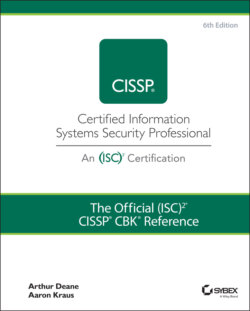Читать книгу The Official (ISC)2 CISSP CBK Reference - Leslie Fife, Aaron Kraus - Страница 38
Security Control Frameworks
ОглавлениеPoor security management is one of the primary culprits for many organizations' security problems. Security management can be accomplished by adopting a top-down approach, bottom-up approach, or some combination of the two.
Historically, enterprises have utilized more of a bottom-up approach to security, in which the IT department takes security seriously and attempts to develop a security function for the company. With this approach, operations staff identify security needs and issues and push those findings up the chain to senior management to provide guidance and funding. This approach tends to result in a company taking reactive measures rather than instituting proactive policies, and often leads to underfunded security programs.
In a top-down approach, senior leadership starts by understanding the regulations and security threats faced by the organization, and initiates strategies, policies, and guidelines that are pushed down throughout the rest of the organization. With a top-down approach, information security is evangelized by the most senior executives at the company, which ensures that security is prioritized and in alignment with the company's overall business strategy. An effective top-down approach requires strong governance (as discussed earlier in this chapter) that starts with aligning with one or more security control frameworks.
A security control is a technical, operational, or management safeguard used to prevent, detect, minimize, or counteract security threats. (ISC)2 defines a security control framework as “a notional construct outlining the organization's approach to security, including a list of specific security processes, procedures, and solutions used by the organization.” Organizations often adopt a security control framework to assist with meeting legal and regulatory compliance obligations, while also helping to build a security program that maintains the confidentiality, integrity, and availability of the company's assets.
NOTE Technical controls are system-based safeguards and countermeasures — things like firewalls, IDS/IPS, and data loss prevention (DLP). Operational controls are safeguards and countermeasures that are primarily implemented and executed by people (as opposed to systems); security guards are a common example. Management controls include policies, procedures, and other countermeasures that control (or manage) the information security risk. Management controls are sometimes referred to as administrative controls, but this should not be confused with activities associated with a system admin (sysadmin). The lines between the three categories can often blur (i.e., many controls fit into more than one of the categories), and many organizations have discontinued use of the terms to avoid confusion. You should be familiar with the concepts, should you come across the terminology in your organization.
Organizations often select security control frameworks based on their industry. For example, the Payment Card Industry (PCI) control framework is a global framework used by financial services organizations and companies that handle cardholder data. In the United States, the Health Insurance Portability and Accountability Act (HIPAA) offers a control framework for healthcare organizations and companies that handle protected health information (PHI). Aside from PCI and HIPAA (which are covered later in this chapter), ISO/IEC, NIST, and CIS provide some of the most frequently adopted security control frameworks used by organizations across multiple industries. While there are many other control frameworks available, you should be familiar with the following frameworks, at a minimum:
ISO/IEC 27001
ISO/IEC 27002
NIST 800-53
NIST Cybersecurity Framework
CIS Critical Security Controls
NOTE The HITRUST (originally known as the Health Information Trust Alliance) Common Security Framework (CSF) was originally developed to address the overlapping regulatory environment in which many healthcare providers operate. It has evolved over time to provide a comprehensive, prescriptive framework that can be used for organizations that exchange any type of sensitive and/or regulated data. Taking into account both risk-based and compliance-based considerations, the HITRUST provides an auditable framework for the evaluation of an organization's security environment.
NOTE Control Objectives for Information Technologies (COBIT) is a framework developed by ISACA (previously known as the Information Systems Audit and Control Association) for overall information technology management and governance and is perhaps the most popular IT governance framework used in industry. While it is not a security-specific control framework, it does outline end-to-end IT governance objectives and processes that encompass many security requirements and concepts. Visit www.isaca.org if you want to learn more about the COBIT framework.
